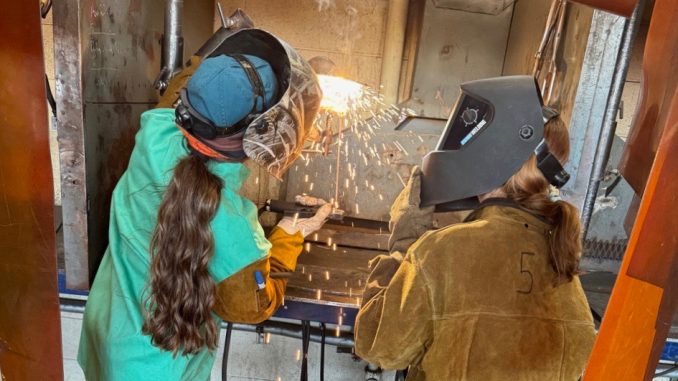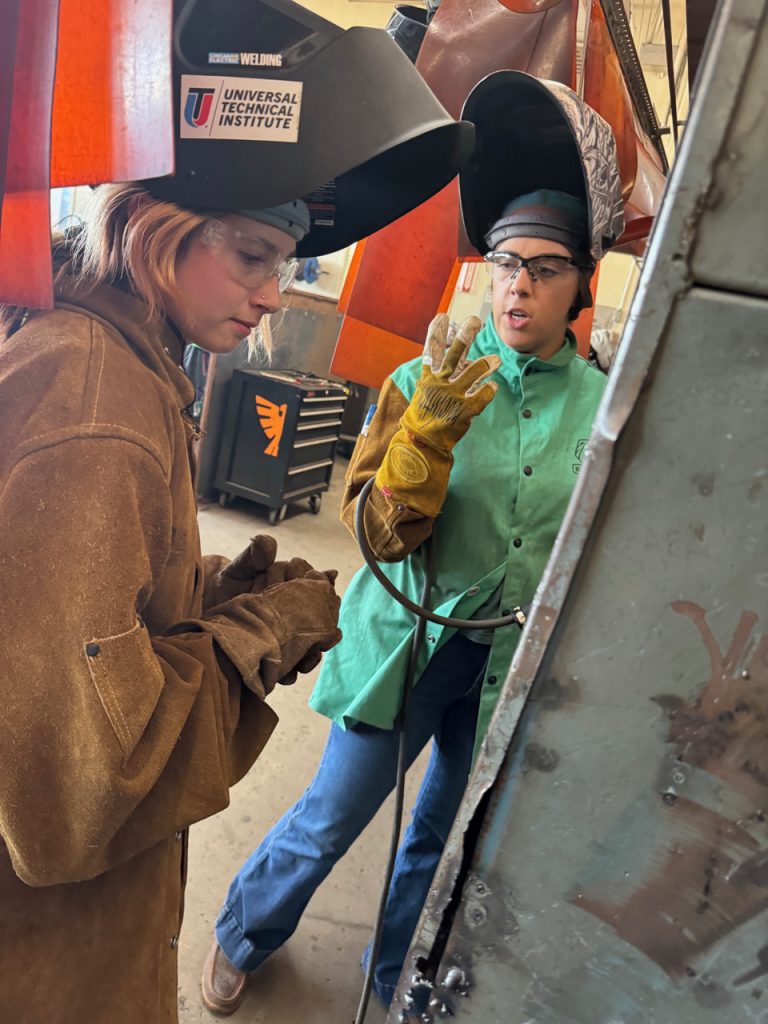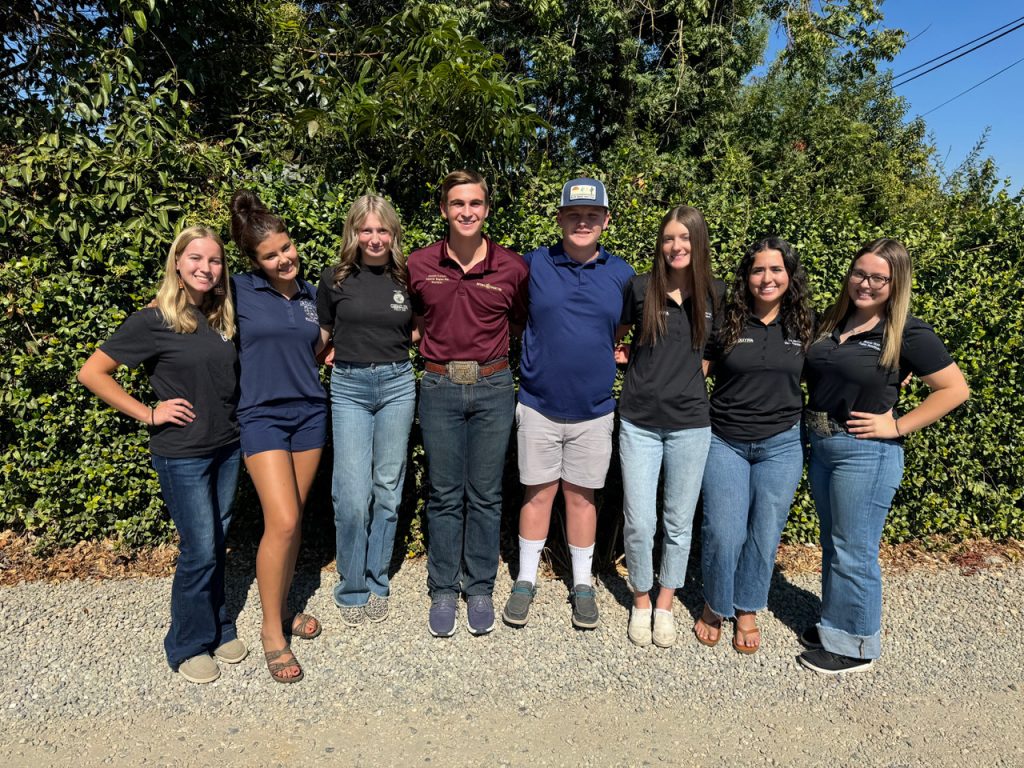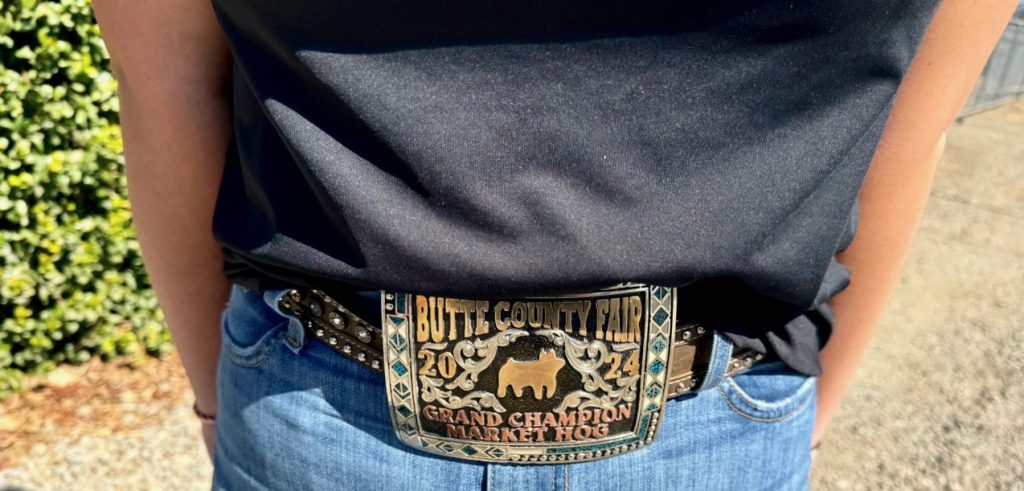
By Helen Harlan
Electra Oxley is a 17-old senior at Las Plumas High School in Oroville who wants to work as a turbine technician on windmills. Oxley is taking Jannie Ford’s advanced Ag welding class at Las Plumas to hone her skills in that direction.
“I want to be the one to go fix them,” she says. “You need to have some experience with AC and DC, which is like the electric stuff, so that will help out in the long run, along with welding.”
Oxley is the only female student in the class. She notes that, even though being the sole girl is annoying, it gives her a different perspective.
“Like, from a guy’s view versus only a chick,” she muses. “I don’t really have very many female friends because I grew up with mostly guys, so it’s kind of fitting.”
According to Ford, who’s called “Ford” and not Ms. Ford by her students, Oxley is excelling.
“She does well,” Ford says. “She holds her own.”
Ag welding is one of the many agricultural education classes and pathways offered by Las Plumas to Butte County high schoolers. Often called “youth ag” or just “Ag,” this type of education falls under the banner of FFA, which is known to many under its older name, “Future Farmers of America.” FFA is a national youth organization run by the Department of Education and the California FFA Association, which currently lists 95,000 individual members in 338 schools.

Celebrity FFA alums include NFL and MLB legend Bo Jackson, Minnesota governor Tim Walz and current uber-icon Taylor Swift.
FFA chapters like Las Plumas’s are part of Career Technical Education Pathways, or CTE, which aims to teach kids hands-on job skills.
“I don’t like being in the classroom – I want these kids in the shop,” Ford stresses. “My goal as a teacher is so that when these kids leave my class, they walk away with some sort of life skill.”
Madison Albiani is one of six Ag teachers at Gridley High School, where half of the student body participates in FFA. Albiani calls the hands-on approach that she and colleagues like Ford teach “phenomenon-based learning.”
“These kids need to see the real-world picture to understand why they need to learn it,” Albiani explains. “And if you can’t give them the ‘why,’ they’ll shut off. It’s about (them) putting their phones away and actually experiencing things.”
FFA is a CTSO, a Career Technical Student Organization, which means that the kids are in charge, and their teachers act as advisors. Like many Ag programs, Gridley has livestock set up on-site and the students care for the animals.
On the last Monday in September, during Ag teacher Madelyn Vaca’s animal science class, the students watched as two of Gridley’s ewes gave birth to three lambs.
“The boys got queasy,” Vaca laughs.
Andrea Thomas, Gridley’s floral Ag teacher, says the experience of seeing live births inspired some students.
“We have some students in the animal science pathway that, yesterday, you would never have thought that lambs giving birth were going to be the biggest thing in their entire life,” Thomas mentions the day after these new arrivals. “But they came back to Ms. Vaca’s class and were totally enthralled and eating up the lambing process.”

Maisie Jane Hurtado comes from multi-generational Butte County almond farmers and FFA enthusiasts. Hurtado grew up helping in her family’s orchards, knowing she wanted to do Ag as a living from a young age. She is a Chico High School grad – class of 1994 – and, as a panther, she was active in FFA.
FFA requires all students to participate in a Supervised Agricultural Experience, or SAE, that allows them to apply what they have learned in the classroom to a real-world setting. California FFA’s list of acceptable SAEs is a grab bag of activities ranging from horseshoeing business to christmas tree production and apiary (or, bee-keeping). Hurtado’s Chico FFA project would have fallen under the current fruit and nut production SAE.
“I wanted to add value to almonds and start selling them,” Hurtado says. “The inspiration came from overhearing conversations from my grandfather, uncles and dad about how we are growing 80% of the world’s almonds here, but you can’t go into the grocery store and find any, especially back 30 years ago.”
At age 17, Hurtado sold her flock of sheep that she raised in 4H, a national youth organization run by the U.S. Department of Agriculture. The 4H program works with students as young as five while teaching similar values as FFA. Hurtado used that money to buy her first 2,000 pounds of almonds. Today, she’s the co-owner of Chico’s own Maisie Jane’s, where she and her family and team produce and sell “nuts, honey, & more.” Hurtado says she learned many skills she needed to run a small business back at Chico FFA.
“I learned bookkeeping and got confident speaking in front of groups there,” Hurtado says. “It gives you a background in preparing your resume and conducting interviews. It’s not just wearing the blue jacket and the show ring and selling an animal.”

Many Butte Ag kids excel when wearing the blue jacket, the standard corduroy mantle which one sports when competing in fairs and shows and showing livestock.
Some, like Gridley junior Gracie Yost, don an accessory with the jacket signaling one of the highest honors in FFA: a champion belt buckle. Yost’s latest buckle reads “Butte County Fair, 2024, Grand Champion Market Hog.” She won it for showing Puff, one of 26 pigs that she’s taken to competitions in three years.
“He had swollen little hocks, so I named him Puff,” Yost says.
When Yost isn’t busy as a “hog jock,” as her peers affectionately call her, she’s the Public Relations Officer for Gridley’s 2024-2025 FFA Chapter Officer Team, the student body that oversees all FFA-related matters.
Yost and her fellow officers meet every Tuesday during lunch in Ms. Vaca’s room to catch up on FFA business. They spend much of their time planning fundraising events, like their “Triple B” dinner and chili cook-off on November 16.
Alina Jackson, 16, a Gridley junior, serves as team secretary. Jackson says it’s already getting stressful leading up to the Triple B event.
“We’re trying to make sure that everything’s in order and it goes smoothly, like making sure that we have sponsors and selling tickets,” she acknowledges. “One wrong turn means the whole thing could go wrong.”
When watching the focused and driven young people of FFA, it’s easy to forget that they’re juggling ag with regular teenage things like sports, academics and college applications in today’s social-media-saturated world.

“I would say that the hardest thing is managing my time between FFA and activities, getting all my work done with my livestock and my animals at home, and keeping up with my schoolwork as well,” says Joe Schohr, 16, a Gridley junior and the current Superior Region FFA Sentinel.
As such, Schohr is responsible for organizing FFA events for the entire region. He wants to go to Kansas State University in Manhattan, Kansas, and aims to earn a PhD on his way to becoming an embryologist and genetics specialists in the beef industry.
Schohr has known Jackson since the fourth grade. Back then, the two participated in 4H together. Like many interviewed for this article, he says the best thing about FFA is his team.
“It sounds cliche, but my favorite thing about FFA is all the people that I get to meet and all the friends that I make,” Schohr reflects. “Some of my closest friends are here in this room as FFA officers.”
Jackson and every other current and former FFA member CN&R spoke with agree there’s never a moment when one is ready to quit Ag.
“I don’t think there’s ever been a time where I thought, ‘Oh, there’s so much going on I can’t handle it,'” Jackson observers. “We can go to our meetings and everything can get all chaotic, but then we’re all working together and bringing it back together. It’s like a little family here.”

Be the first to comment